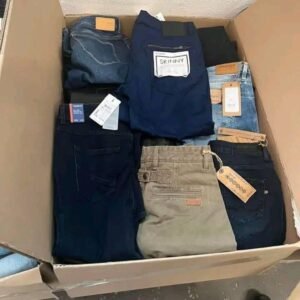The World of Cotton Clothes: A Detailed Insight.clothing pallets for sale
Cotton, often referred to as “the fabric of our lives,” is one of the most widely used and loved natural fibers in the world. From soft T-shirts to luxurious bedding, cotton garments dominate the textile industry due to their comfort, versatility, and sustainability.
In this article, we’ll explore the history, production process, benefits, types, and care of cotton clothing, along with its role in modern fashion and sustainability.clothing pallets for sale
A Brief History of Cotton
Cotton has played an essential role in human civilization for thousands of years. Here’s a look into its fascinating journey:
- Origins: The cultivation of cotton dates back to around 5,000 BCE in regions like the Indus Valley (modern-day Pakistan and India), Egypt, and Peru.
- Trade and Industrial Revolution: Cotton became a vital trade commodity along ancient routes like the Silk Road. During the 18th century, the Industrial Revolution transformed cotton production with the invention of the spinning jenny, power loom, and cotton gin.clothing pallets for sale
- Global Spread: Today, cotton is grown in over 80 countries, with major producers being India, China, the USA, and Brazil.
How Cotton Clothes Are Made
The journey of cotton from field to wardrobe involves several steps:clothing pallets for sale
- Cultivation:
- Cotton plants are grown in warm climates, and the cotton bolls (seed pods) are harvested when they mature.
- The fibers are separated from the seeds using a machine called a cotton gin.
- Spinning:
- The raw cotton fibers are cleaned, carded (aligned), and spun into yarn or thread.clothing pallets for sale
- Weaving or Knitting:
- The yarn is woven (interlaced) or knitted (looped) into fabric, creating different textures and designs.
- Dyeing and Finishing:
- Cotton fabric is dyed in various colors or patterns. Finishing processes like mercerization may enhance the fabric’s luster, strength, and dye absorption.
- Garment Production:
- The fabric is cut and sewn into clothing items such as shirts, pants, dresses, and more.
Benefits of Cotton Clothes
Cotton garments are a staple in wardrobes worldwide for a reason. Here are some of the key benefits:
- Comfort:
- Cotton is soft, breathable, and gentle on the skin, making it ideal for everyday wear.clothing pallets for sale
- It’s hypoallergenic, which means it rarely causes irritation, making it suitable for people with sensitive skin or allergies.
- Moisture Absorption:
- Cotton can absorb up to 27 times its weight in water, keeping you dry and comfortable in hot and humid conditions.
- Durability:
- Cotton is strong and long-lasting, especially when properly cared for.clothing pallets for sale
- Versatility:
- Cotton can be woven or blended to create a wide range of fabrics, from lightweight muslin to durable denim.
- Sustainability:
- As a natural fiber, cotton is biodegradable and renewable, making it an eco-friendly choice compared to synthetic fabrics.
Types of Cotton Fabrics
Cotton can be transformed into various types of fabrics, each with unique characteristics:
- Plain Cotton:
- A lightweight and breathable fabric often used in T-shirts, blouses, and summer dresses.
- Denim:
- A durable, twill-woven fabric used for jeans and jackets.clothing pallets for sale
- Muslin:
- A sheer, plain-woven cotton fabric, often used in lightweight garments or as a base for tailoring.
- Poplin:
- A smooth and crisp fabric ideal for shirts, skirts, and dresses.
- Canvas:
- A heavy-duty fabric used in outerwear, bags, and upholstery.clothing pallets for sale
- Egyptian Cotton:
- Known for its extra-long fibers, Egyptian cotton is considered a luxury fabric for high-quality shirts and bed linens.
- Pima Cotton:
- Soft and durable, Pima cotton is often used in premium garments and activewear.
Caring for Cotton Clothes
Proper care can extend the life of your cotton clothes and keep them looking fresh:
- Washing:
- Use cold or warm water to prevent shrinkage and fading.clothing pallets for sale
- Avoid overloading the washing machine, as cotton fibers need room to move.
- Drying:
- Air-dry cotton garments whenever possible to reduce wear and tear from high heat.
- If using a dryer, opt for a low-heat setting.
- Ironing:
- Cotton wrinkles easily, so ironing on medium heat is often necessary for a polished look.
- Storage:
- Store cotton clothes in a cool, dry place to prevent mold or mildew.clothing pallets for sale
Cotton in Modern Fashion
Cotton remains a staple in both casual and high-fashion apparel, thanks to its adaptability and appeal:
- Everyday Wear: From basic T-shirts to breathable undergarments, cotton dominates casual clothing.
- Luxury Fashion: Designers often use high-quality cotton fabrics like Pima or Egyptian cotton for premium collections.
- Activewear: Cotton blends are increasingly used in sportswear for their breathability and wicking properties.clothing pallets for sale
- Sustainable Fashion: With a growing focus on environmental impact, organic cotton is becoming a popular choice. Organic cotton is grown without synthetic pesticides or fertilizers, reducing harm to the environment and farmers.
Cotton and Sustainability
While cotton is a natural and renewable resource, conventional cotton farming has environmental challenges, including high water usage and pesticide reliance. However, the industry is making strides toward sustainability:

- Organic Cotton:
- Grown using eco-friendly methods, organic cotton reduces chemical usage and promotes soil health.
- Water-Saving Techniques:
- Innovations like drip irrigation and rain-fed farming aim to reduce water consumption in cotton cultivation.clothing pallets for sale
- Recycled Cotton:
- Recycled cotton, made from pre- or post-consumer waste, minimizes textile waste and resource use.
- Fair Trade Cotton:
- Fair trade certification ensures that farmers receive fair wages and work in safe conditions.
Interesting Facts About Cotton Clothes
- Cotton makes up 40% of the world’s clothing.
- A single bale of cotton (approximately 500 pounds) can produce 215 pairs of jeans or 1,200 T-shirts.
- India is the largest cotton producer, while the USA is one of the largest exporters.
Cotton clothes are an integral part of our lives, offering comfort, durability, and style. As the world increasingly embraces sustainable practices, cotton’s future in the textile industry looks brighter than ever.
Whether you’re lounging in a soft cotton hoodie or dressing up in a crisp cotton shirt, this versatile fabric continues to deliver timeless appeal.clothing pallets for sale







Reviews
There are no reviews yet.